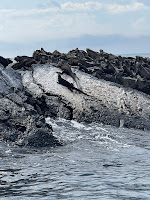April 4: Day 12. We arose with really sore bodies from the bouncing and craning we experienced on yesterday’s zodiac tours. Jane is really moving poorly.
 |
| Sunrise over Fernandina |
 |
| Pelicans nest in mangroves |
Known for its continuing series of volcanic eruptions, the island is the most volcanically active and sits at the center of the hotspot that created the Galapagos Islands. This uninhabited island is the archipelago’s most pristine of the volcanoes and is home to its youngest ecosystem.
Although our bodies are screaming “NO!,” we ready ourselves for the morning’s zodiac exploration of the island’s coastline of Punta Mangle. Unlike some of the other islands, this coastline is filled with tiny bays and coves of tall mangroves. As our panga approaches the coastline we spot two manta rays swimming around each other on the water’s surface.
 |
| Our Ninja panga pilot! |
 |
| Panga Jane |
While we are having lunch, the ship was repositioned to the
coastline of Punta Moreno on Isabela Island, the largest of the Galapagos
Islands.
With an area of 1,771 mi.², the island is larger than all the other
islands in the chain combined. One of the youngest islands at approximately 1
million years old, Isabela is located near the Galapagos hotspot and was formed
by the merger of 6 shield volcanoes.
 |
| Lava cacti |
The island straddles the equator and has around 2000 permanent inhabitants.
Our group assembled at the Basecamp at our appointed time for a zodiac tour of the coastline. We find the coastline to have unique lava formations, but the lava fields are relatively new and have not developed sufficient soil nutrients required to support the vegetation zones found on other islands.
 |
| Galapagos penguin |
 |
| Penguin pair |
It is the second smallest and rarest penguin species, and is confined specifically to the Galapagos Islands. Ninety percent of the approximately 1200 mature penguins are found on Fernandina Island and the west coast of Isabela Island. They are considered endangered primarily due the large die offs that occur during the warmer conditions of El Niño seasons. It is our 8th species of penguin that we have seen in the wild.
 |
| Marine iguanas |
As we approach a rocky outcrop our guide points out another unique Galapagos species—the marine iguana. Found only in the Galapagos Islands, this herbivorous marine reptile is the only lizard that spends its time in a marine environment foraging for algae. It is theorized that marine and land iguanas share a common ancestor. It is distributed throughout the entire archipelago, with varying appearances between the different islands and several sub species being recognized.
 |
| Iguana colony |
 |
| Sally Lightfoot crabs |
Back
aboard our ship, we gathered on the observation deck to relax and were Linda
and Jane decided to refresh themselves in the spa. A little later on, we had to
make a tough decision as to whether to attend a ceviche cooking class put on by
the executive chef, or go to happy hour. The drinks were really good!
 |
| No iguanas in here! |

No comments:
Post a Comment